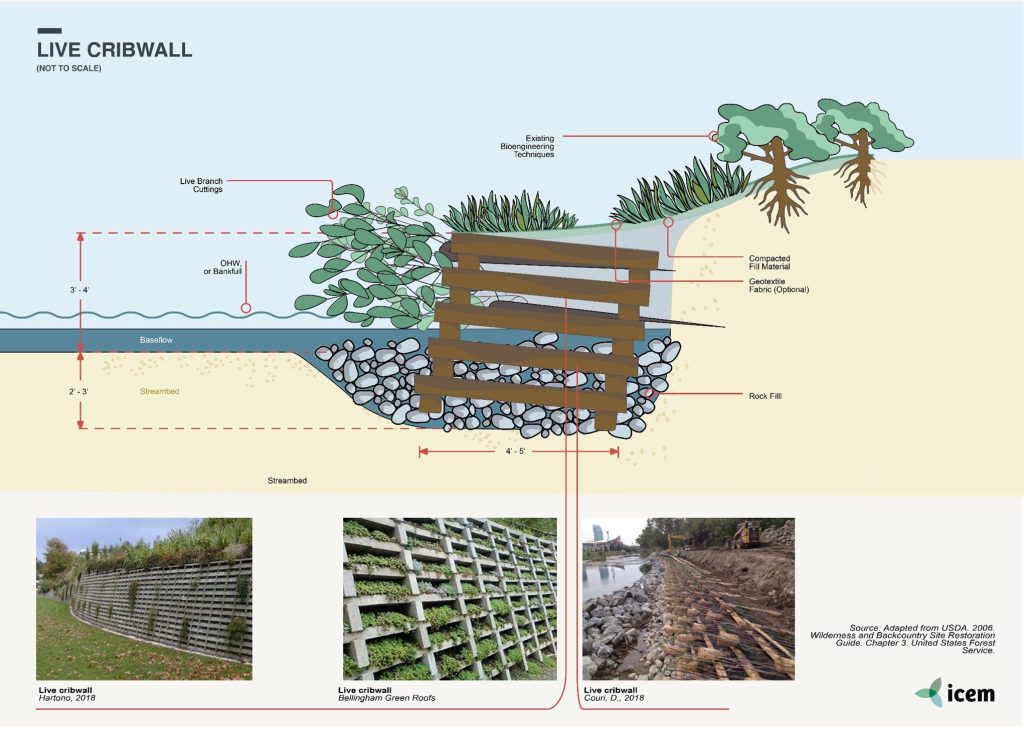| Suburban | River | Medium-cost | Riverbank erosion | |
| DESCRIPTION | |
| Measures
|
A live crib wall is a form of gravity-retaining structure used to stabilize a river bank. It is formed by an interlocking frame of untreated log or timber members and the structure is filled with suitable backfill material and layers of live branch cuttings which then root inside the crib structure and extend into the slope. Once the live cuttings root and become established, the subsequent vegetation gradually takes over the structural functions of the wood members and after becoming established the root systems stabilize the bank. |
| Location
|
Live crib walls are used to stabilize banks and protect them from undercutting. They can be used on steep slopes and are effective on outside bends of streams where the bank is eroding and where strong currents are present and can also be used to stabilize the toe of a slope from minor movements and settlements or to stabilize the base of slopes which have failed |
| Design options and performance | Long-lasting hardwood timber species are used they can be used to stabilize the longitudinal profile of stream beds and to avoid regressive erosion along riverbanks. They provide immediate protection from mass overturning but are not intended to resist large, lateral earth stresses or used where large soil volumes need to be stabilized. |
| Feasibility criteria
|
● Technical design: The frame is constructed using logs and anchor logs held together with nails and placed horizontally to form an angle of 10-15° toward the slope. Horizontal logs of length up to 10 m are laid at the base of the slope in the longitudinal direction and fixed in position by nailing interlocking transverse logs (headers) of length > 1-2 m running back into the slope. Interlocking can be achieved by cutting notches and fixing them with wire. The next horizontal course is then placed on top of the headers, and back-filled with earth and a layer of live wood.
● Soil media: Native bank soil. ● Soil slope: Crib walls are an effective measure to support or repair very steep banks which are eroding or collapsing. ● Surface cover: Once the crib wall frame is constructed it is backfilled with soil from the bank and shaped to conform with the adjacent embankment. ● Materials: Logs for the frame, live brushwood cuttings and binding materials. |
| Operation and maintenance | The structure and plantings should be inspected after high-flow events. Live cuttings or plantings can be added to areas with low growth. |
| Cost and benefits | This is a low or medium-cost system depending on the supply of logs and the complexity. It is very effective at stabilizing the bank and provides immediate protection against mass overturning. As the root systems and foliage grow, they provide long-term stability. It is a suitable measure to stabilize loose materials at the toe of the bank or to stabilize the base of slopes which have failed. If robust timber species are used they can be used to stabilize the longitudinal profile of stream beds and to avoid regressive erosion along a riverbank. It also adds to the biodiversity of the site and creates new habitats. |
| Design solution | Vegetated crib walls are constructed using timber and/or logs which are placed in rows on a terrace constructed along the toe of a bank. The terrace is sloped back towards the slope at 10-15° to increase stability. The first set of timbers is laid horizontally at the base of the slope in the longitudinal direction, and fixed in position by nailing sharpened interlocking stakes running back into the slope. The spacing of these depends on the slope of the bank to be retained. Transverse logs of approximately 1.5 m width are then laid on top so that they intersect into the slop and are locked together with the longitudinal by cutting notches and fixed with wire. The next horizontal course is then placed on top of the headers, and back-filled with earth and a layer of live wood. |
| Environmental performance | Live crib walls maintain a natural streambank appearance, offer immediate protection from erosion and provide excellent habitat while established vegetation provides long-term stability. |
| Sources | ● Federal Interagency Stream Restoration Working Group (FISRWG). 1988. Live Crib Walls Stream Corridor Restoration: Principles, Processes, and Practices
● Mississippi Watershed Management Organization. 2017. A Guide to Bank Restoration Options for Large River Systems: Part II Bioengineering Installation Manual. ● USDA Natural Resources Conservation Service, 1996. Chapter 16: Streambank and Shoreline Protection Manual. |
Originally developed under the ADB ‘TA-9417 VIE: Secondary Green Cities Development Project – Output 2: Demonstrated sustainable and resilient development in Hue, Ha Giang and Vinh Yen’. Adapted for the UN-CTCN project ‘Climate risk assessment for subnational adaptation and establishment of a local climate information system for climate change adaptation (LISA) in Cambodia’.



